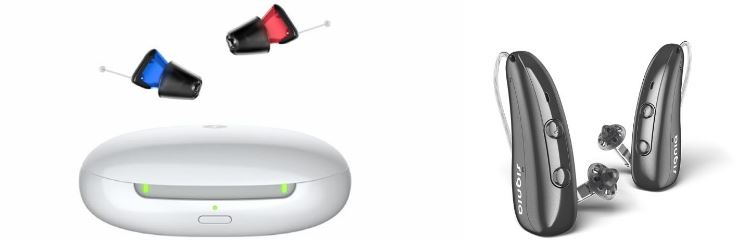by Brian Taylor, AuD, Signia

Brian Taylor, AuD
Think back to when you last studied mathematics and recall the transitive property. If A equals B and B equals C, then A equals C. In audiology, as researchers continue to explore the relationship between hearing loss (A) and cognitive decline (C), I’m often drawn, along with many patients, to issues of (B) – social isolation and the ways that better hearing can help them re-engage with friends, family, and the world around them.
What does the transitive property have to do with anything? As we know, for decades, studies have suggested the connection between hearing loss and cognitive decline. But they’ve also traced successfully the relationships between hearing loss and social isolation, and between social isolation and cognitive decline. In a nutshell, hearing loss can cause people to withdraw from social situations, and a lack of socialization — even loneliness — can lead to cognitive decline and other health issues.
So it stands to reason, if hearing loss can lead to social isolation and social isolation can lead to cognitive decline, then hearing loss can impact cognitive decline.
And this is important, because as audiologists, we need to be judicious in drawing a line directly from hearing loss to cognitive decline. As my colleague Jan Blustein, M.D., Ph.D. discussed this month at AuDacity 2024, the annual conference of the Academy of Doctors of Audiology, there’s much we’re still learning about the causational relationship between the two. But we can begin to explain the factors of hearing loss that may impact (not necessarily cause) cognitive decline, like social isolation, which leads to reduced brain stimulation and less cognitive reserve for fending off the effects of decline.
For those with untreated hearing loss, one of the best ways to fend off social isolation and its associated risks is to enable better communication — to allow them to reconnect with the conversations their hearing loss might otherwise hinder.

Hearing Aids Promote Social Engagement
Among the studies exploring the connection between hearing health and cognitive health are those that specifically suggest hearing aids can slow cognitive decline, including related conditions such as dementia. These studies are encouraging, but as many have pointed out, there’s still much to discern about the difference between correlation and causation.
But we know pretty well that hearing aids can help with socialization, emotional health, and wellbeing. Indeed, hearing aids can amplify what the wearer has been missing, making them feel more part of their surroundings. But the key to improving socialization is to help them, well, socialize. And that’s where advances in hearing aid technology come into play.
To keep those with hearing loss from withdrawing, risking isolation, and thereby putting their cognitive health in jeopardy, hearing aids had to evolve to support the most basic yet challenging social situation: group conversation.
Because it’s one thing to improve someone’s ability to have a one-directional dialogue in a noisy restaurant, for example. It’s another to account for multiple speakers changing positions and entering the conversation at different times and volumes — especially in noisy environments.
Yet that’s what group conversation is. It’s naturally dynamic. After years developing hearing aids that reduce background noise and better preserve speech, a new class now fully accounts for the dynamism of conversation, allowing wearers to reconnect, contribute, engage and avoid the social isolation that could threaten their cognitive health.

Reconnecting with the Conversation
At Signia, this new class of hearing aid is designed around its Integrated Xperience (IX) platform, the first of its kind specifically engineered to optimize performance in group conversations and social situations. It builds on Signia’s 20-year legacy of wireless communication between the wearer’s left and right hearing aids and enables Integrated Xperience devices to detect and boost conversations from three acoustic snapshots in front of the wearer and one behind. Other hearing aids provide one front-facing acoustic snapshot to help improve the wearer’s conversational ability and engagement, but in fast-changing, dynamic social situations, that’s simply not enough.
Signia Integrated Xperience is unique in its multi-stream architecture, which can pinpoint multiple moving conversation partners in real-time. It can process up to four focus streams using Signia’s RealTime Conversation Enhancement solution, which analyzes, augments, and adapts to the dynamic flow of multi-party conversation environments.

What’s more, hearing aids developed with the Integrated Xperience platform, such as the Signia Styletto IX, Silk Pure Charge&Go IX and Insio IX have been engineered to be both discrete and stylish. This helps normalize and even conceal the hearing aids themselves, so the wearer feels more confident using them and thereby engaging in group conversation.
And it’s really this confidence we’re after. The confidence to embrace hearing health and the confidence to reconnect with conversation. Because conversation and social engagement are crucial aspects of cognitive health.
As HCPs, we can continue to discuss and explore how best to position hearing aids as supporting cognitive health.
But as hearing technology makes great strides, it’s critical that we take advantage to address what we can with today’s advancements. Hearing aids can now reconnect people with the group conversations they long to enjoy (A), effectively mitigating the social isolation they might otherwise fall into (B). In doing so, we establish how hearing health supports cognitive health (C) and overall well-being.
As my math teacher used to put it, “quod erat demonstrandum.”
About the Author
Brian Taylor, AuD, is Senior Director of Audiology at Signia, a division of WS Audiology. He is also the editor of Audiology Practices, a quarterly journal of the Academy of Doctors of Audiology, editor-at-large for Hearing Health and Technology Matters and adjunct instructor at the University of Wisconsin.






